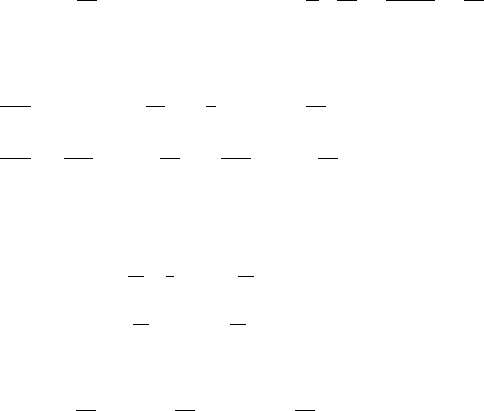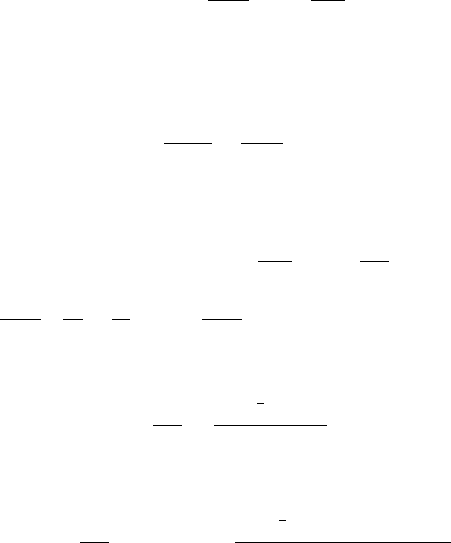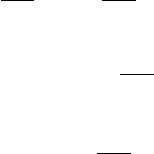Myint Tyn U., Debnath L. Linear Partial Differential Equations for Scientists and Engineers
Подождите немного. Документ загружается.


14.7 The Rayleigh–Ritz Approximation Method 651
I (u)=
D
u
2
x
+ u
2
y
dx dy.
We seek an approximate series solution in the form
u
2
(x, y)=a
1
φ
1
+ a
2
φ
2
with a
1
= 1 so that u
2
satisfies the given boundary conditions, that is,
φ
1
= f and φ
2
=0on∂D. Substituting u
2
into the functional gives
I (u
2
)=
D
∂u
2
∂x
2
+
∂u
2
∂y
2
dx dy
=
D
(∇φ
1
)
2
dx dy +2a
2
D
(∇φ
1
·∇φ
2
) dx dy
+ a
2
2
D
|∇φ
2
|
2
dx dy.
The necessary condition for an extremum of I (u
2
)is
∂I
∂a
2
=0,
or
2
D
(∇φ
1
·∇φ
2
) dx dy +2a
2
D
|∇φ
2
|
2
dx dy =0.
Therefore,
a
2
= −
**
(∇φ
1
·∇φ
2
) dx dy
**
|∇φ
2
|
2
dx dy
.
This a
2
minimizes the functional and the approximate solution is obtained.
However, this procedure can be generalized by seeking an approximate
solution in the form
u
n
=
n
i=1
a
i
φ
i
(a
1
=1)
so that φ
1
= f and φ
i
=0(i =2, 3,...,n)on∂D.
The coefficients a
i
can be obtained by solving the system (14.7.7) with
j =2,3,..., n.
Example 14.7.2. A uniform elastic beam of length l carrying a uniform load
W per unit length is freely hinged at x = 0 and x = l. Find the approximate
solution of the boundary-valu e problem
EI
(iν)
y
(x)=W,
y = y
′′
=0 at x = 0 and x = l,

652 14 Numerical and Approximation Methods
where y = y (x) is the displacement function.
This problem is equivalent to finding a function y (x) that minimizes
the energy functional
I (y)=
l
0
Wy −
EI
2
y
′′2
dx.
We seek an approximate solution
y
n
(x)=
n
r=1
a
r
sin
rπx
l
which satisfies the boundary conditions.
Substitution of this solution into the energy functional gives
I (y
n
)=
n
r=1
l
0
Wa
r
sin
rπx
l
dx −
EI
2
l
0
r
4
π
4
l
4
a
2
r
sin
2
rπx
l
dx
=
2Wl
π
n
r=1
a
r
r
−
EIπ
4
4l
3
n
r=1
r
4
a
2
r
.
The necessary conditions for extremum are
0=
∂I
∂a
r
=
2Wl
rπ
−
EIπ
4
4l
3
2a
r
r
4
,r=1, 2,...,n
which give a
r
as
a
r
=
4Wl
4
π
5
r
5
EI
,r=1, 2,...,n.
Thus, the approximate function y (x)is
y
n
(x)=
4Wl
4
π
5
EI
n
r=1
1
r
5
sin
rπx
l
.
The maximum deflection at x = l/2is
y
max
=
4Wl
4
π
5
EI
1 −
1
3
5
+
1
5
5
− ...
.
In this case, the first term of the series solution gives a reasonably good
approximate solution as
y
1
(x) ∼
4Wl
4
EIπ
5
sin
πx
l
.

14.7 The Rayleigh–Ritz Approximation Method 653
Example 14.7.3. Apply the Rayleigh–Ritz method to investigate the free
vibration of a fixed elastic wedge of constant thickness governed by the
energy functional
I (y)=
1
0
αx
3
y
′′2
− ωxy
2
dx, y (1) = y
′′
(1) = 0,
where the free vibration is described by the function u (x, t)=e
iω t
y (x), ω
is the frequency.
We seek an approximate solution in the form
y
n
(x)=
n
r=1
a
r
y
r
(x)=
n
r=1
a
r
(x − 1)
2
x
r−1
which satisfies the given boundary conditions.
We take only the first two terms so that y
2
(x)=a
1
y
1
+ a
2
y
2
=(x − 1)
2
(a
1
+ a
2
x). Substituting y
2
into the functional we obtain
I
2
= I (y
2
)=
1
0
"
αx
3
(6a
2
x +2a
1
− 4a
2
)
2
− ωx (x − 1)
4
(a
1
+ a
2
x)
2
#
dx
= α
(a
1
− 2a
2
)
2
+
24
5
(a
1
− 2a
2
) a
2
+6a
2
2
−
ω
5
a
2
1
6
+
2a
1
a
2
21
+
a
2
2
56
.
The necessary conditions for an extremum are
∂I
2
∂a
1
=2a
1
α −
ω
30
+
2
5
a
2
2α −
ω
21
=0,
∂I
2
∂a
2
=
2a
1
5
2α −
ω
21
+
2a
2
5
2α −
ω
56
=0.
For nontrivial solutions, the determinant of this algebraic system must be
zero, that is,
α −
ω
30
1
5
2α −
ω
21
2α −
ω
21
2α −
ω
56
=0,
or
5
α −
ω
30
2α −
ω
56
−
2α −
ω
21
2
=0.
This represents the frequency equation of the vibration which has two roots
ω
1
and ω
2
. The smaller of these two frequencies gives an approximate value
of the fundamental frequency of the vibration of the wedge.
Example 14.7.4. An elastic beam of length l, density ρ, cross-sectional area
A, and modulus of elasticity E has its end x = 0 fixed and the other end

654 14 Numerical and Approximation Methods
connected to a rigid support through a linear elastic spring with spring
constant k. Apply the Rayleigh–Ritz method to investigate the harmonic
axial motion of the beam.
The kinetic energy and t he potential energy associated with the axial
motion of the beam are
T =
l
0
ρA
2
U
2
t
dx, V =
l
0
EA
2
U
2
x
dx +
k
2
U
2
(l, t) ,
where U (x, t) is the displacement function.
Since the axial motion is simple harmonic, U (x, t)=u (x) e
iω t
,where
ω is the frequency of vibration. Consequently, the expressions for T and V
canbewrittenintermsofu (x). We then apply the Hamilton variation al
principle
δI (u)=δ
t
2
t
1
l
0
1
2
ρAω
2
u
2
− EA u
2
x
dx −
k
2
u
2
(l)
dt =0.
The Euler–Lagrange equation for the variational principle is
d
dx
EA
du
dx
+ ρAω
2
u =0, 0 <x<l,
EA
du
dx
+ ku =0, at x = l.
In terms of nondimensional variables (x
∗
,u
∗
)=(1/l)(x, u) and parame-
ters λ =
ω
2
ρl
2
/E
and α =(kl/EA), this system becomes, dropping the
asterisks,
u
xx
+ λu =0, 0 <x<1,
u
x
+ αu =0, at x =1.
The associated functional for the system is
I (u)=
1
2
1
0
λu
2
− u
2
x
dx −
α
2
u
2
(1) .
According to the Rayleigh–Ritz method, we seek approximate solution with
α = 1 in the form
u
2
(x)=a
1
x + a
2
x
2
so that I (u
2
) is minimum.
We substitute u
2
(x) into the fu nction al to obtain
I
2
= I (u
2
)=
1
2
l
0
"
λ
a
1
x + a
2
x
2
2
− (a
1
+2a
2
x)
2
#
dx −
1
2
(a
1
+ a
2
)
2
.

14.8 The Galerkin Approximation Method 655
The necessary conditions for extremum of the functional are
0=
∂I
2
∂a
1
= a
1
λ
3
− 2
+ a
2
λ
4
− 2
,
0=
∂I
2
∂a
2
= a
1
λ
4
− 2
+ a
2
λ
5
−
7
3
.
For nontrivial solutions, the determinant of system must be zero, that is,
λ
3
− 2
λ
4
− 2
λ
4
− 2
λ
5
−
7
3
=0,
or
3λ
2
− 128λ + 480 = 0.
This quadratic equation gives two solutions:
λ
1
=4.155,λ
2
=38.512.
The corresponding valu es of the frequency are given by
ω
1
=2.038
E
ρl
2
1
2
,ω
2
=6.206
E
ρl
2
1
2
.
The exact solution is determined by the transcendental equation
√
λ + tan
√
λ =0.
The first two roots of this equation can be obtained graphically as
ω
01
∼ 2.0288
E
ρl
2
1
2
,ω
02
∼ 4.9132
E
ρl
2
1
2
.
14.8 The Galerkin Approximation Method
As an extension of the Rayleigh–Ritz method, Galerkin formulated an in-
genious approximation method which may be applied to a problem for
which no simple variational principle exists. The differential operator A in
equation (14. 7.1) need not be linear for the solution of this equation. In
order to solve the boundary-value problem (14.7.1)–(14.7.2), we construct
an approximate solution u (x) in the form
u
n
(x)=u
0
(x)+
n
i=1
a
i
φ
i
(x) , (14.8.1)
656 14 Numerical and Approximation Methods
where the φ
i
(x) are known functions, u
0
is introduced to satisfy the bound-
ary conditions, and the coefficients a
i
are to be determined. Substituting
(14.8.1) into (14.7.1) gives a non-zero residual R
n
R
n
(a
1
,a
2
,...,a
n
,x,y)=A (u
n
)=A (u
0
)+
n
i=1
a
i
A (φ
i
) . (14.8.2)
In this method the unknown coefficients a
i
are determined by solving the
following system of equations
R
n
,φ
j
=0,j=1, 2,...,N. (14.8.3)
Since A is linear, this can be written as
n
i=1
a
i
A (φ
i
) ,φ
j
= −Au
0
,φ
j
, (14.8.4)
which determines the a
′
j
s. Substitution of the a
′
j
s obtained from the solution
of (14.8.4) into (14.8.1) gives th e required approximate solution u
n
.
We find an interesting connection between the Galerkin solution and
the Fourier representation of the function u. We seek a Galerkin solution
in the form
u
n
(x)=
n
i=1
a
i
φ
i
(x) , (14.8.5)
with a special restriction on the operator A which satisfies the condition
Aφ
i
,φ
j
=
⎧
⎨
⎩
0,i= j
1,i= j.
(14.8.6)
Thus, the application of the Galerkin metho d to (14.7.1) gives
n
i=1
A (φ
i
) ,φ
j
a
i
= f,φ
i
, (14.8.7)
which is, by (14.8.6),
a
j
= f,φ
j
, (14.8.8)
so the Galerkin solution (14.8.5) becomes
u
n
(x)=
n
i=1
f,φ
i
φ
i
(x) . (14.8.9)
Evidently, the Galerkin solution (14.8.5) is just the finite Fourier series
solution.

14.8 The Galerkin Approximation Method 657
Finally, we shall cite an example to show the equivalence of the Galerkin
and Rayleigh–Ritz methods. We consider the Poisson equation
u
xx
+ u
yy
= f (x, y)inD ⊂ R
2
(14.8.10)
with a homogeneous boundary condition u =0on∂D. The solution of this
equation is equivalent to finding the minimum of the functional
I (u)=
D
u
2
x
+ u
2
y
+2fu
dx dy. (14.8.11)
According to the Rayleigh–Ritz method, we seek a trial solution in the
form
u
n
=
n
i=1
a
i
φ
i
(x, y) , (14.8.12)
where the trial functions φ
i
are chosen so that they satisfy the given bound-
ary condition on ∂D.
We substitute the Rayleigh–Ritz solution u
n
into I (u) and then use
∂I (u
n
) /∂a
k
=0,fork =1,2,..., n to obtain
2
D
∂u
n
∂x
∂φ
k
∂x
+
∂u
n
∂y
∂φ
k
∂y
+ fφ
k
dx dy =0. (14.8.13)
Application of Greens theorem with the homogeneous boundary condition
leads to
D
∇
2
u
n
− f
φ
k
dx dy =0, (14. 8.14)
or
R
n
,φ
k
=0,R
n
≡∇
2
u
n
− f. (14.8.15)
This is the Galerkin equation for the undetermined coefficients a
k
.This
establishes the equ ivalence of the two methods.
Example 14.8.1. Use the Galerkin method to find an approximate solution
of the Poi sson equation
∇
2
u ≡ u
xx
+ u
yy
= −1inD = {(x, y):|x| <a,|y| <b}
with the boundary conditions
u =0 on ∂D = {(x, y):x =+
a, y =+b}.
We seek a trial solution in the form

658 14 Numerical and Approximation Methods
u
N
(x, y)=
N
m,n=1
N
3,5,...
a
mn
φ
mn
(x, y) ,
where
φ
mn
(x, y)=cos
mπx
2a
cos
nπy
2b
.
In this case A = ∇
2
and the residual R
N
is
R
N
= Au
N
+1=∇
2
u
N
+1
= −
N
m=1
N
n=1
m
2
π
2
4a
2
+
n
2
π
2
4b
2
a
mn
φ
mn
+1.
According to the Galerkin method
0=R
N
,φ
kl
=
a
−a
b
−b
R
N
cos
kπx
2a
cos
lπy
2b
dx dy
=
abπ
2
4
k
2
a
2
+
l
2
b
2
a
kl
−
16ab
π
2
kl
(−1)
{(k+l)/2}−1
,
or
a
kl
=
8ab
π
2
2
(−1)
1
2
(k+l)−1
(b
2
k
2
+ a
2
l
2
)
.
Thus, the solution of the problem is
u
N
(x, y)=
8ab
π
2
2
N
m,n=1
N
3,5,...
(−1)
1
2
(m+n)−1
φ
mn
(x, y)
(b
2
m
2
+ a
2
n
2
)
.
In particular, the solution for u
N
(x, y) can be derived for the square
domain D = {(x, y):|x| < 1, |y| < 1}. In the limit N →∞, these solutions
are in perfect agreement with those obtained by th e double Fourier series.
Example 14.8.2. Solve the problem in Example 14.8.1 by using algebrai c
polynomials as trial functions.
We seek an appropriate solution in th e form
u
N
(x, y)=
x
2
− a
2
y
2
− b
2
a
1
+ a
2
x
2
+ a
3
y
2
+ a
4
x
4
y
4
+ ...
.
Obviously, this satisfies the boundary conditions. In the first approximation,
the solution assumes the form
u
1
(x, y) ≡ a
1
φ
1
= a
1
x
2
− a
2
y
2
− b
2
,

14.9 The Kantorovich Method 659
where the coefficient a
1
is determined by the Galerkin integral
a
−a
b
−b
∇
2
u
1
+1
φ
1
dx dy =0,
or
a
−a
b
−b
2a
1
y
2
− b
2
+2a
1
x
2
− a
2
+1
!
x
2
− a
2
y
2
− b
2
dx dy =0.
A simple evaluation gives
a
1
=
5
4
a
2
+ b
2
−1
,
and hence, the solution is
u
1
(x, y)=
5
4
a
2
+ b
2
−1
x
2
− a
2
y
2
− b
2
.
14.9 The Kantorovich Method
In 1932, Kantorovich gave an interesting generalization of the Rayleigh–
Ritz method which leads from the solution of a partial differential equation
to the solution of a system of algebraic equations in terms of unknown
coefficients. The essence of the Kantorovich method is t o reduce the problem
of the solution of partial differential equations to the solution of ordinary
differential equations in terms of undetermined functions.
Consider the boundary-value problem governed by (14.7.1)–(14.7.2). It
has been shown in Section 14.7 that the solution of the problem is equivalent
to finding the minimum of the quadratic functional I (u) given by (14.7.3).
When the Rayleigh–Ritz method is applied to this problem, we seek
an approximate solution in the form (14.7.6) where the coefficients a
k
are
constants. We then determine a
k
so as to minimize I (u
n
).
In the Kantorovich metho d , we assume that a
k
in (14.7.6) are no longer
constants but unknown functions of one of the independent variables x of
x so that the Kantorovich solution has the form
u
n
(x)=
n
k=1
a
k
(x) φ
k
(x) , (14.9.1)
where the products a
k
(x) φ
k
(x) satisfy the same boundary conditions as
u. Thus, the problem leads to minimizing the functional
I (u
n
(x)) = I
n
k=1
a
k
(x) φ
k
(x)
. (14.9.2)

660 14 Numerical and Approximation Methods
Since φ
k
(x) are known functions, we can perform integration with
respect to all independent variables except x and obtain a fun ctional
¯
I (a
1
(x) ,a
2
(x) ,..., a
n
(x)) depending on n unknown functions a
k
(x)of
one independent variable x. These functions must be so determined that
they minimize the functional
¯
I (a
1
,a
2
,...,a
n
). Finally, under certain con-
ditions, t he solution u
n
(x) converges to the exact solution u (x)asn →∞.
In order to describe the method more precisely, we consider the following
example in two dimensions:
∇
2
u = f (x, y)inD, (14.9.3)
u (x , y)=0 on ∂D, (14.9.4)
where D is a closed domain bounded by the curves y = α (x), y = β (x)
and two vertical lines x = a and x = b.
The solution of the problem is equivalent to finding the minimum of the
functional
I (u)=
D
u
2
x
+ u
2
y
+2fu
dx dy. (14.9.5)
We seek the solution in the form
u
n
(x, y)=
n
k=1
a
k
(x) φ
k
(x, y) (14.9.6)
which satisfies the given boundary condition, where φ
k
(x, y)areknown
trial functions, and a
k
(x) are unknown fu nction s to be determined so that
they minimize I (u
n
). Substitution of u
n
in the functional I (u)gives
I (u
n
)=
D
∂u
n
∂x
2
+
∂u
n
∂y
2
+2fu
n
dx dy
=
b
a
dx
β(x)
α(x)
⎧
⎨
⎩
n
k=1
∂φ
k
∂x
a
k
− φ
k
a
′
k
2
+
n
k=1
a
k
∂φ
k
∂y
2
+2f
n
k=1
a
k
φ
k
⎫
⎬
⎭
dy (14.9.7)
=
b
a
F (x, a
k
,a
′
k
) dx, (14.9.8)
where the integrand in (14.9.7) is a known function of y and the integration
with respect to y is assumed to have been performed so th at the result can
be denoted by F (x, a
k
,a
′
k
). Thus, the problem is reduced to determining
the functions a
k
so that they minimize I (u
n
). Hence, a
k
(x) can be found
by solving the following system of linear Euler equations:
